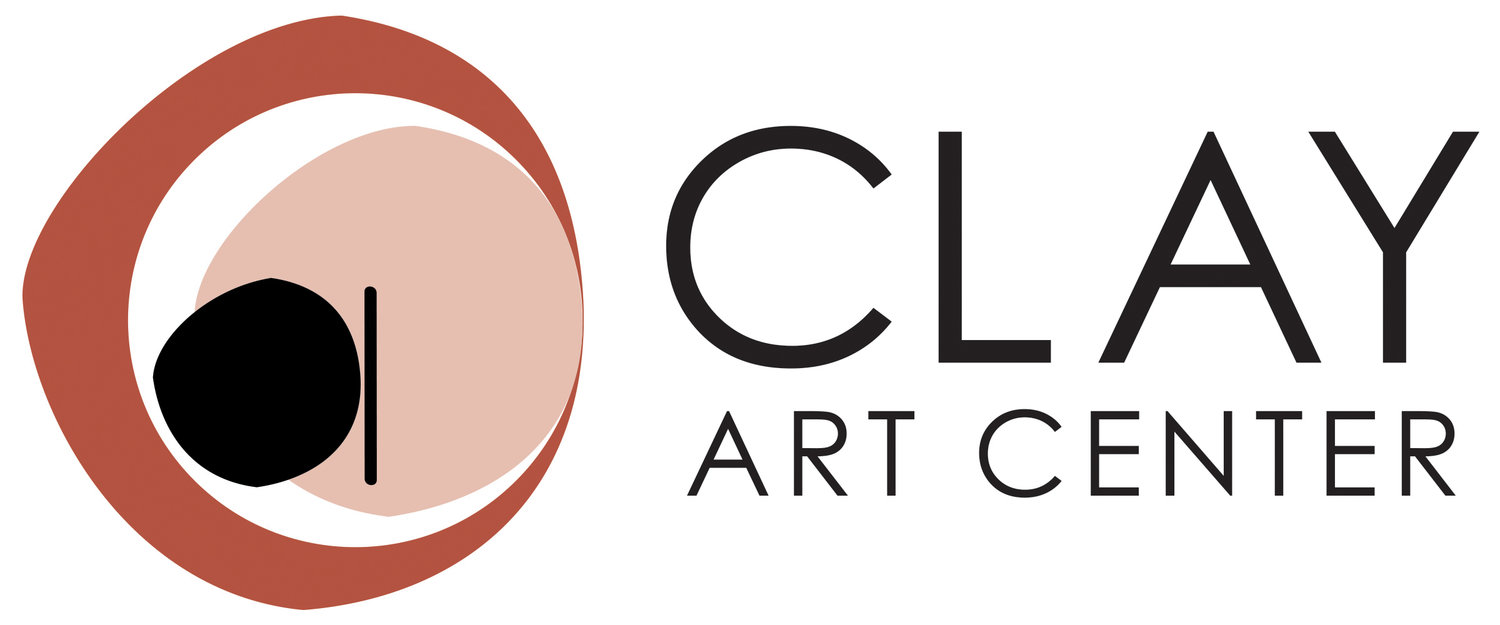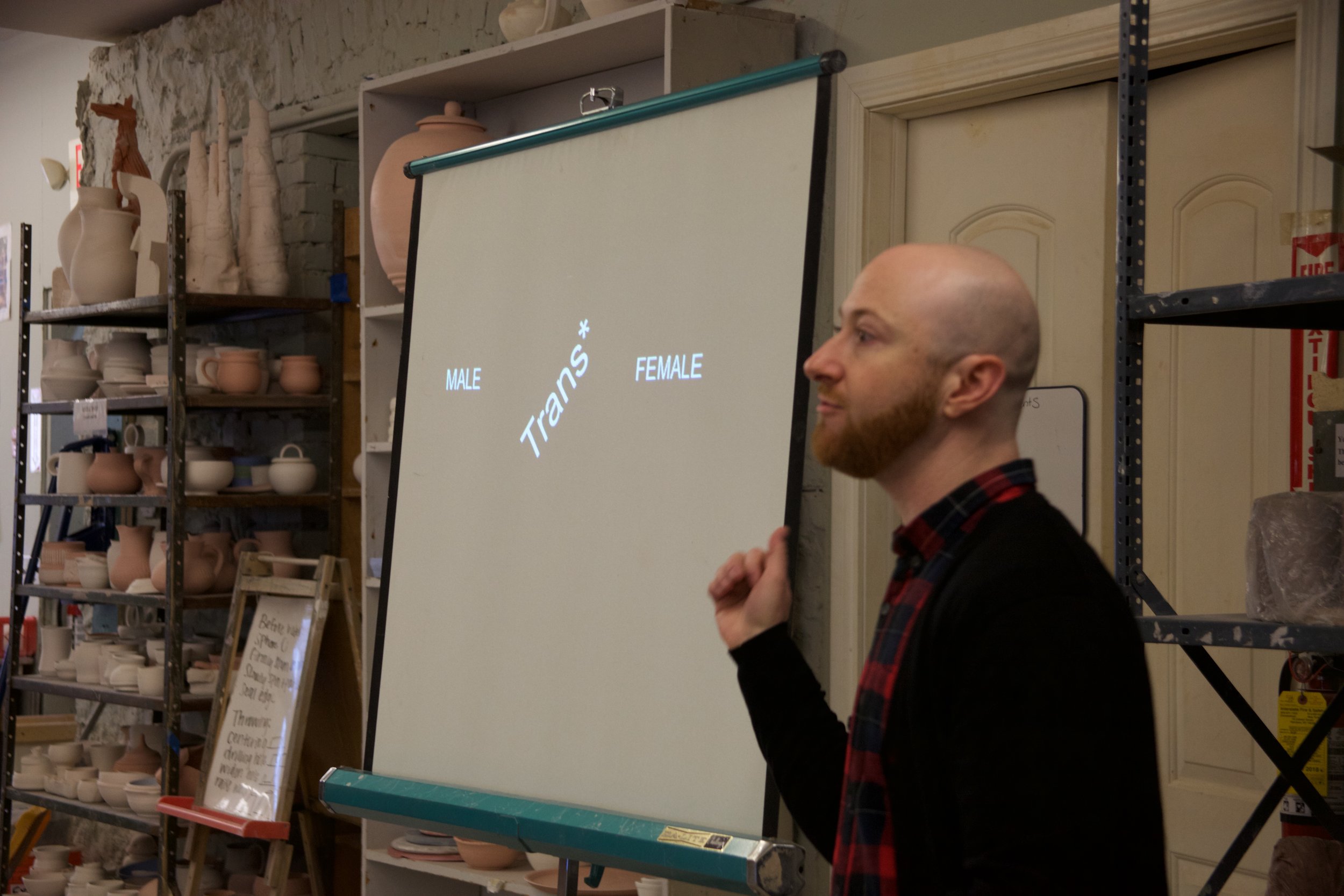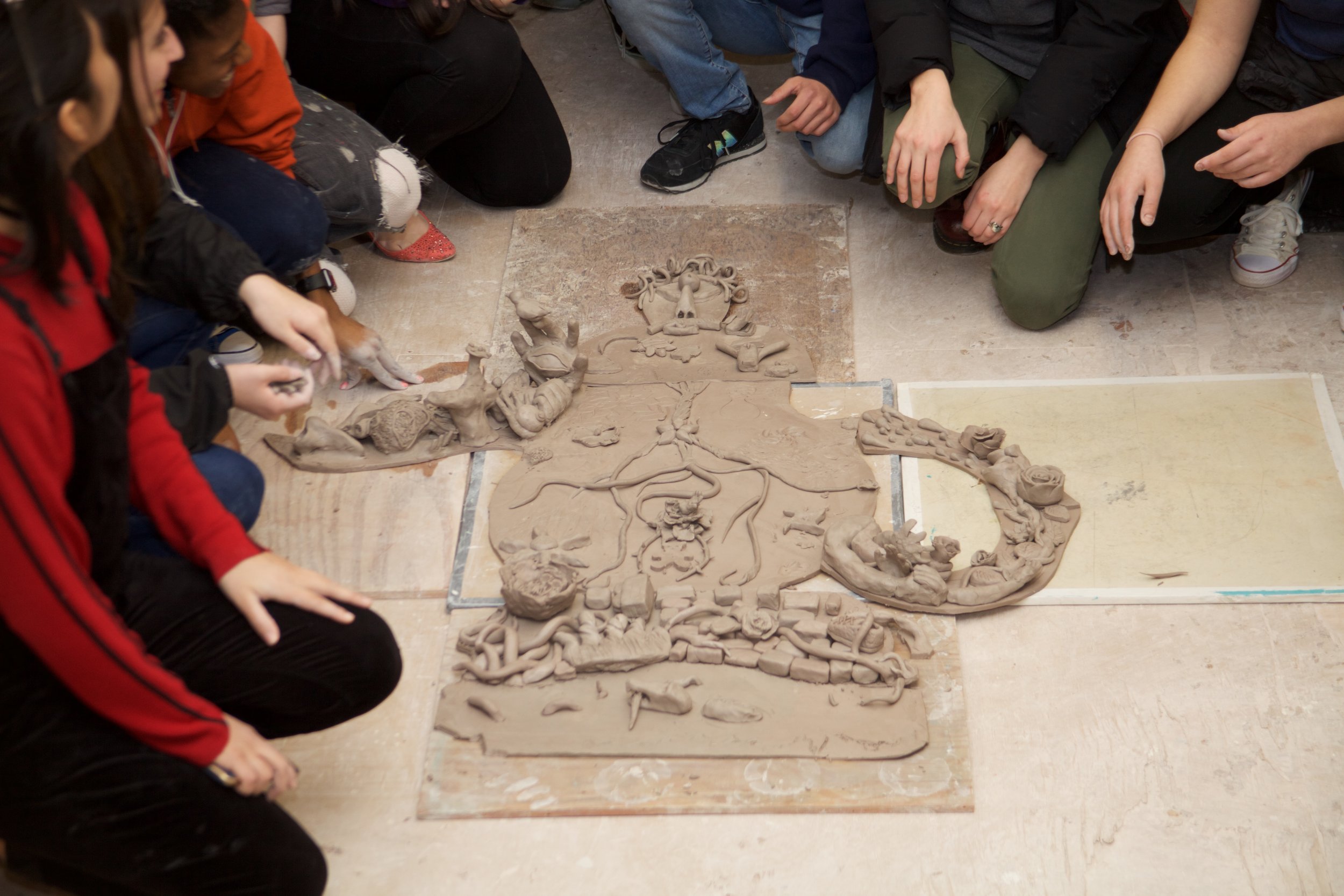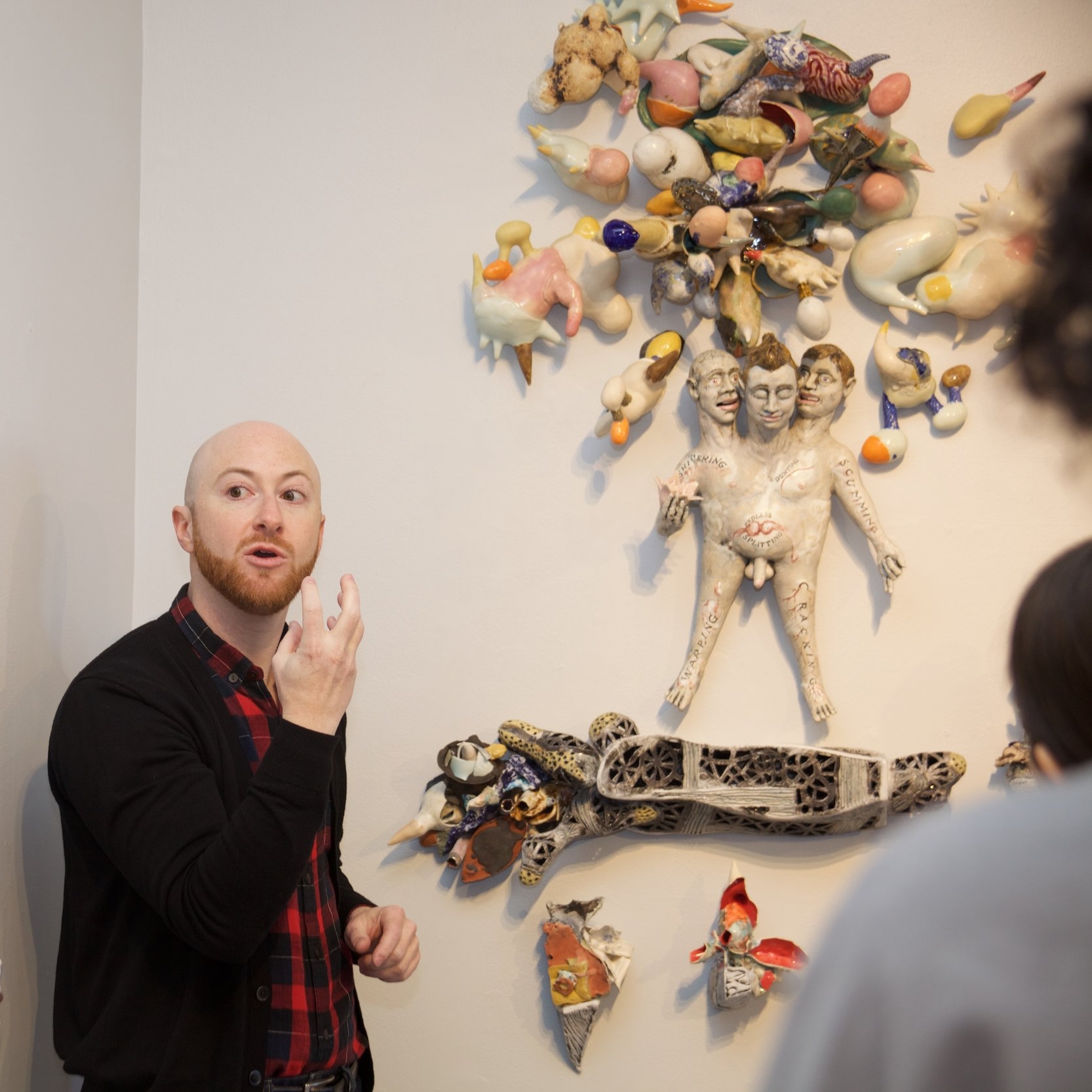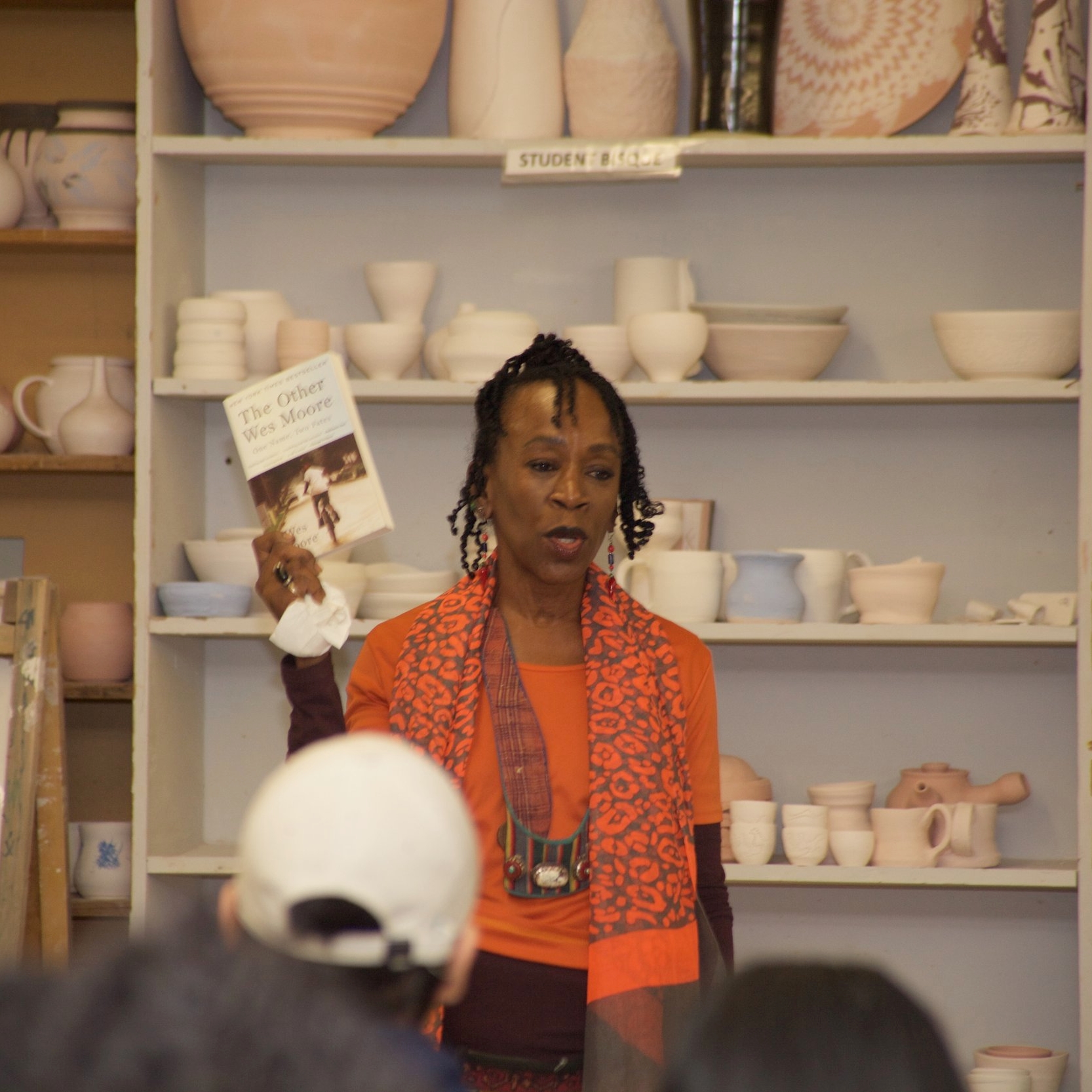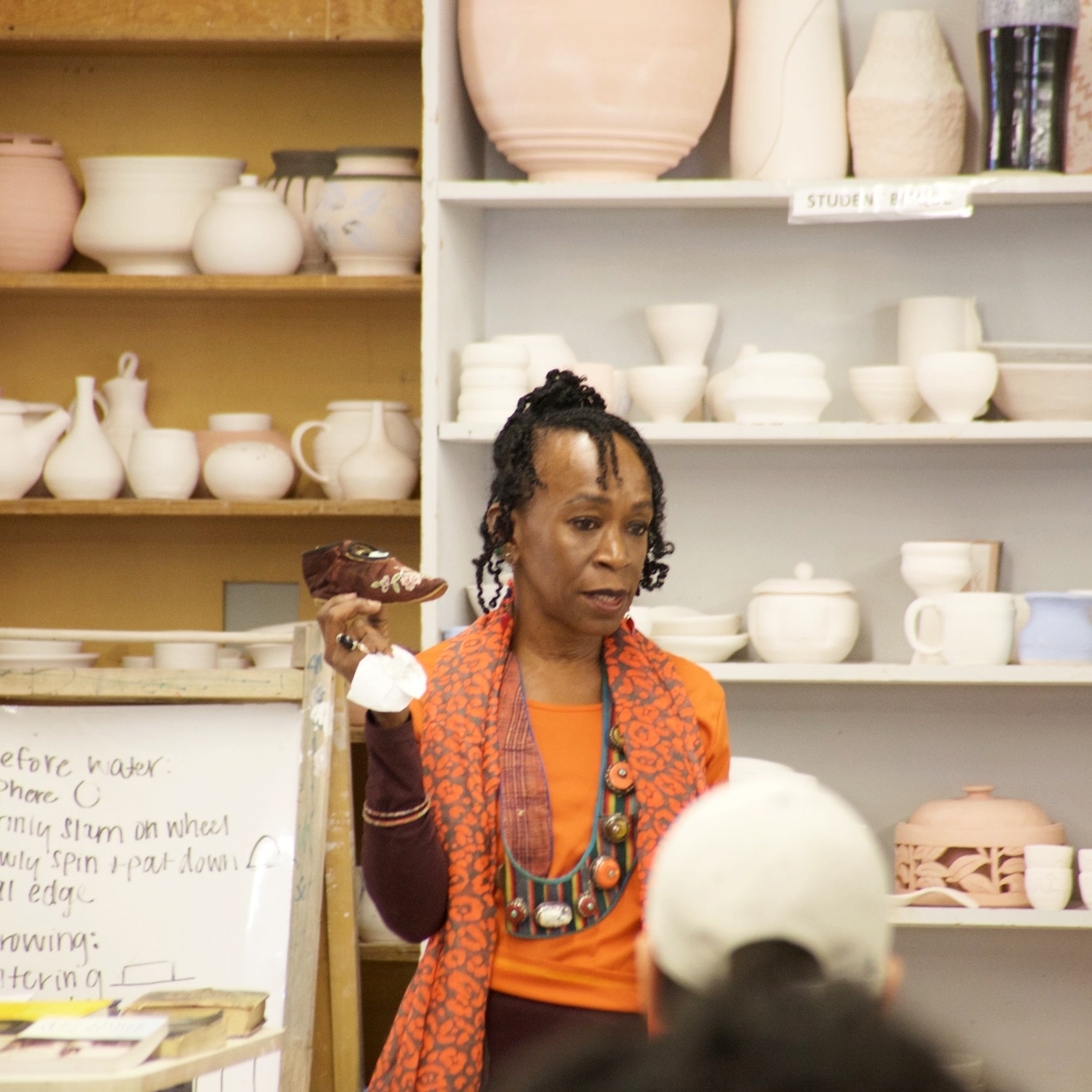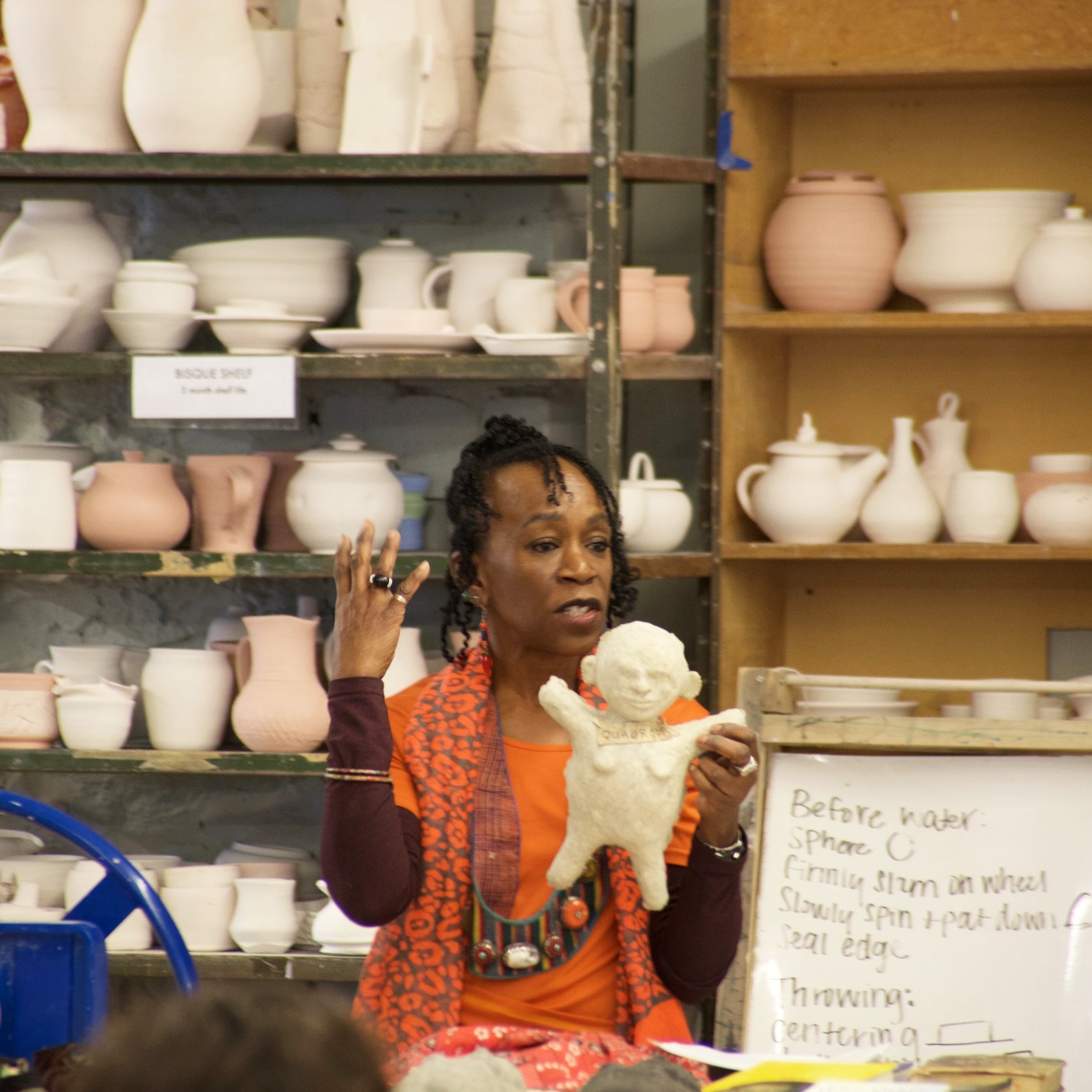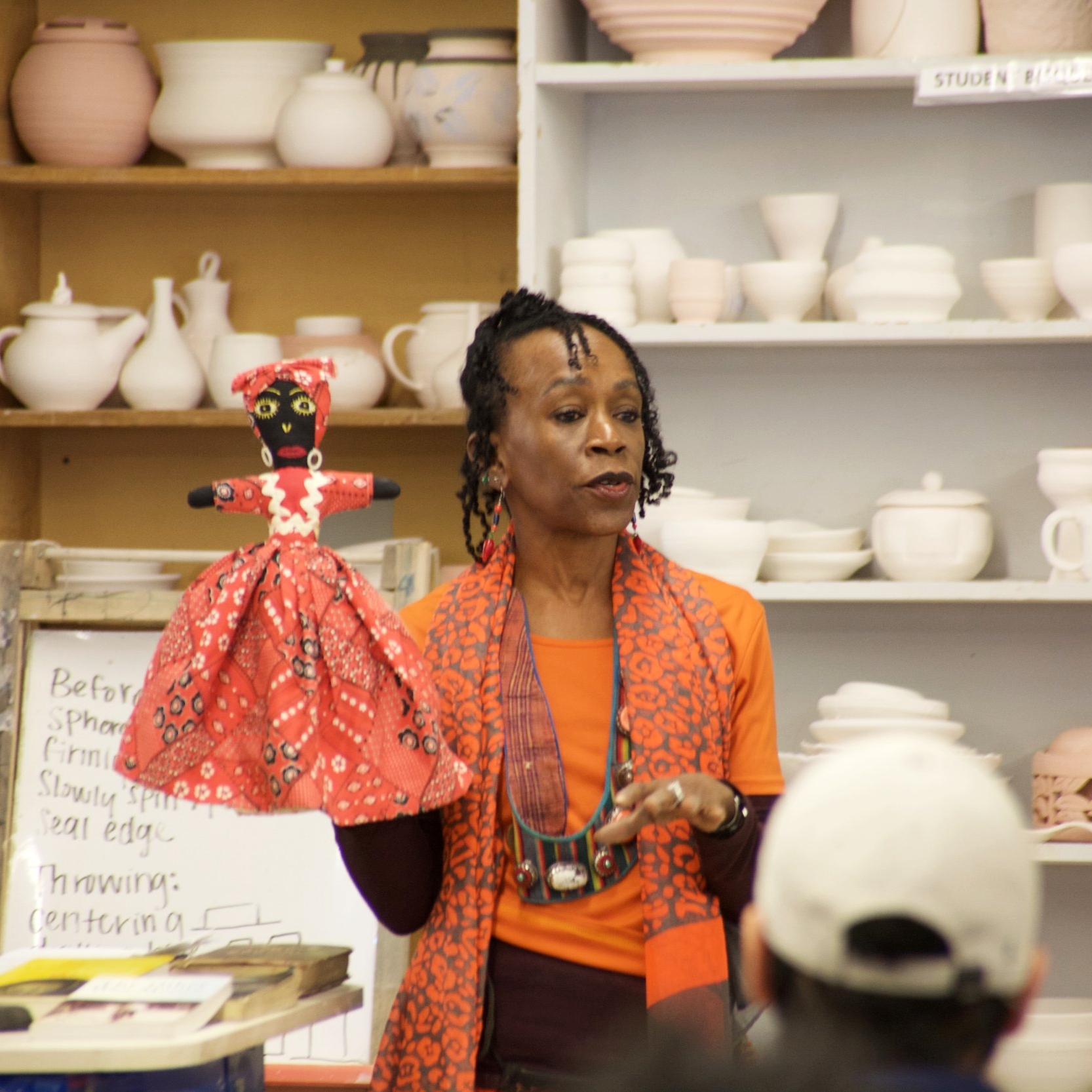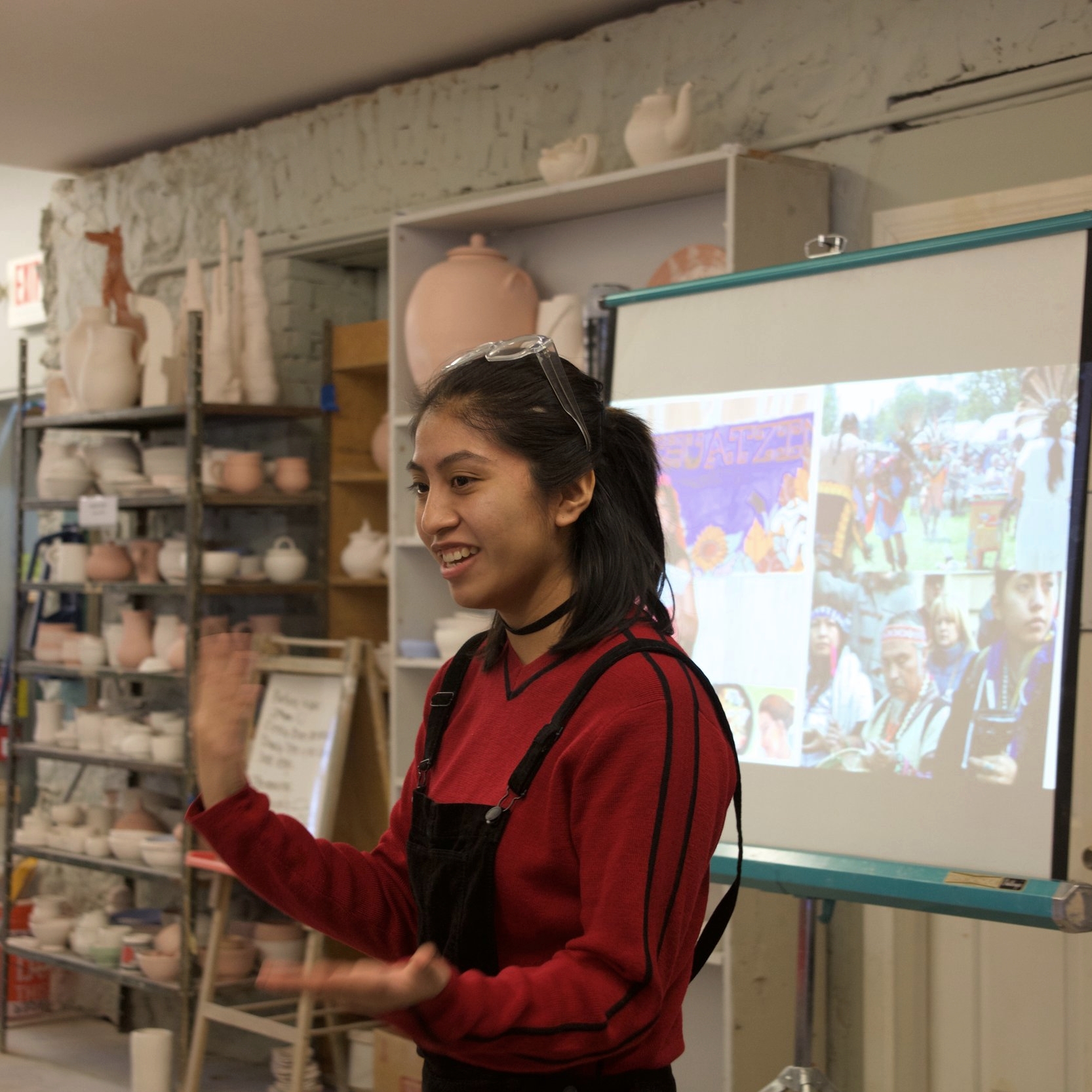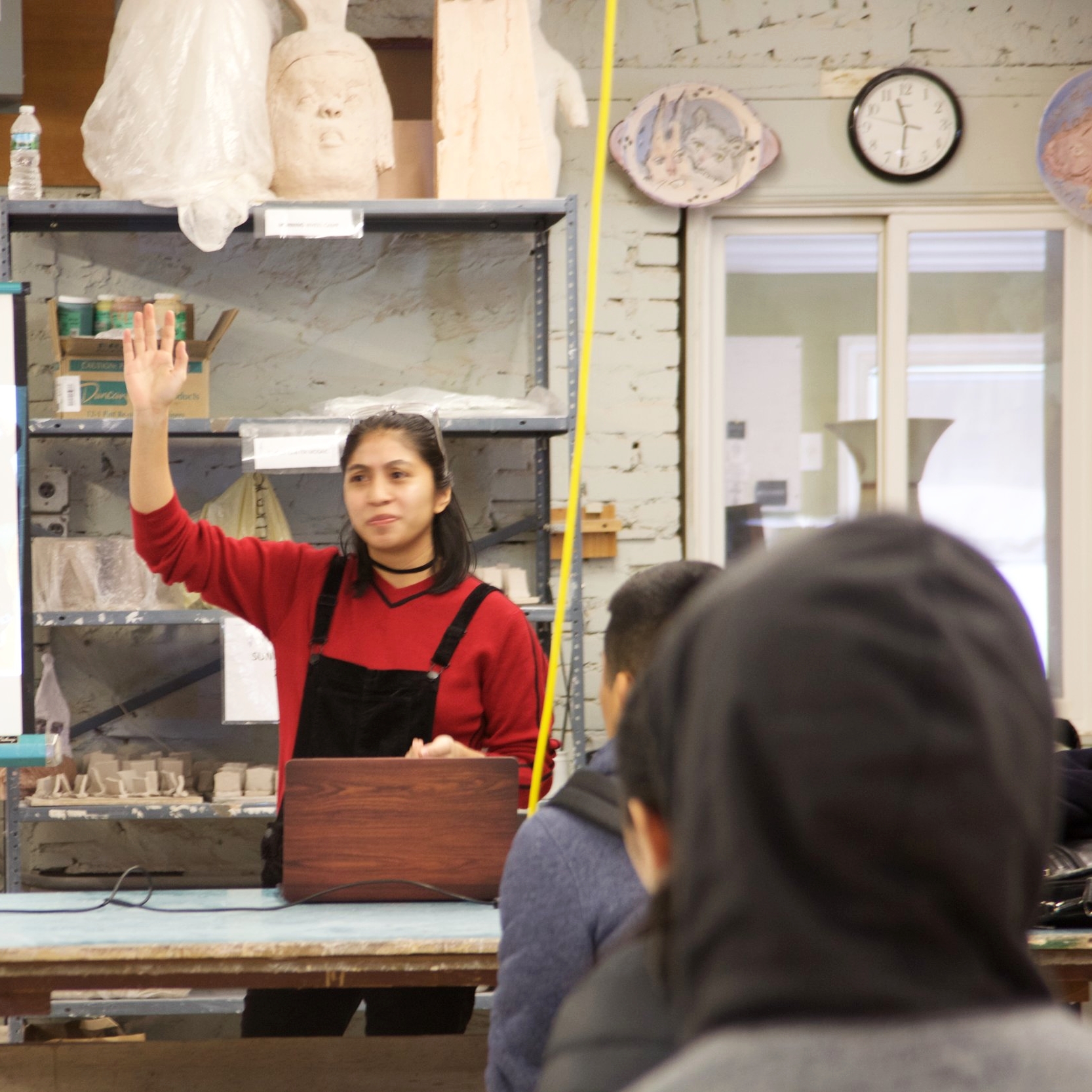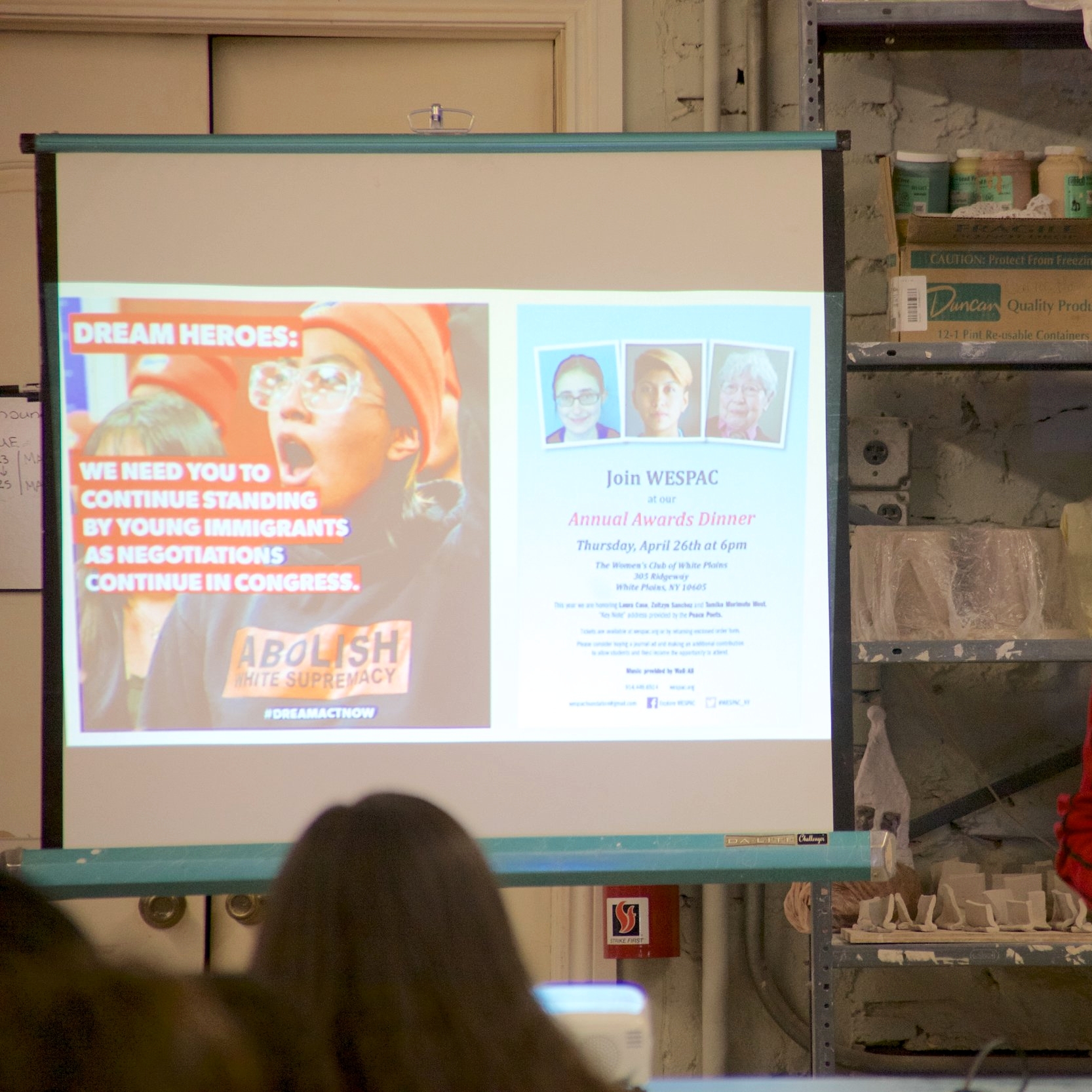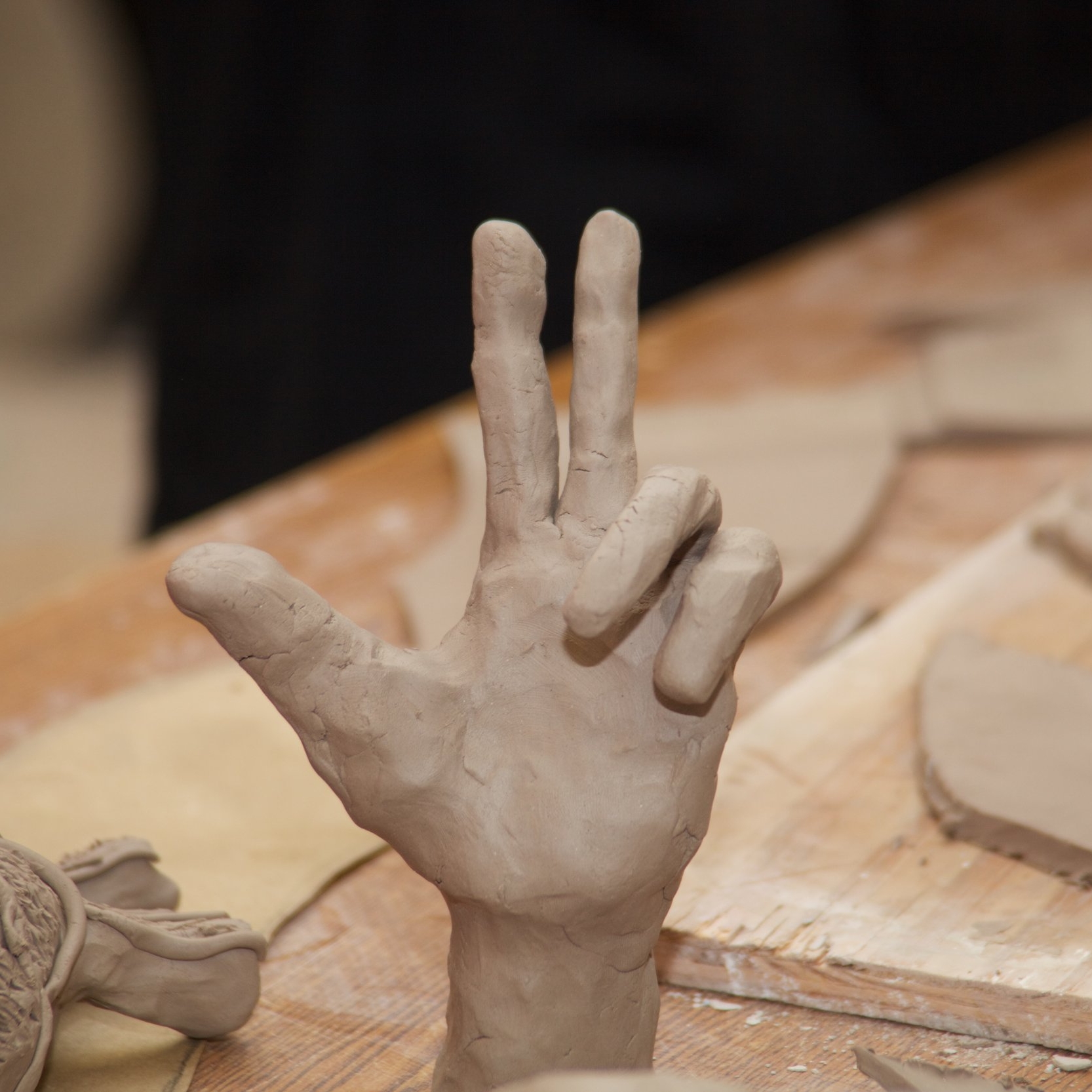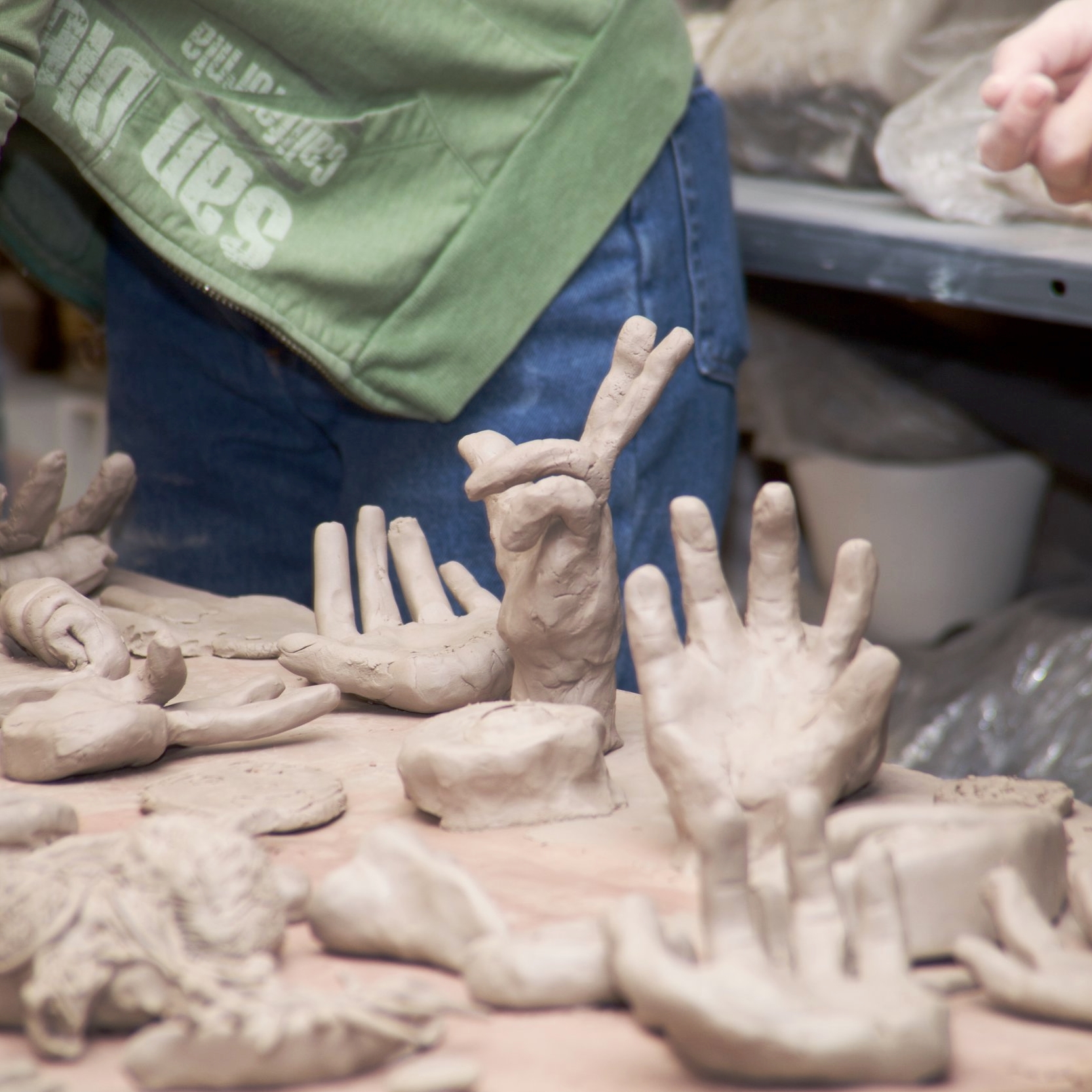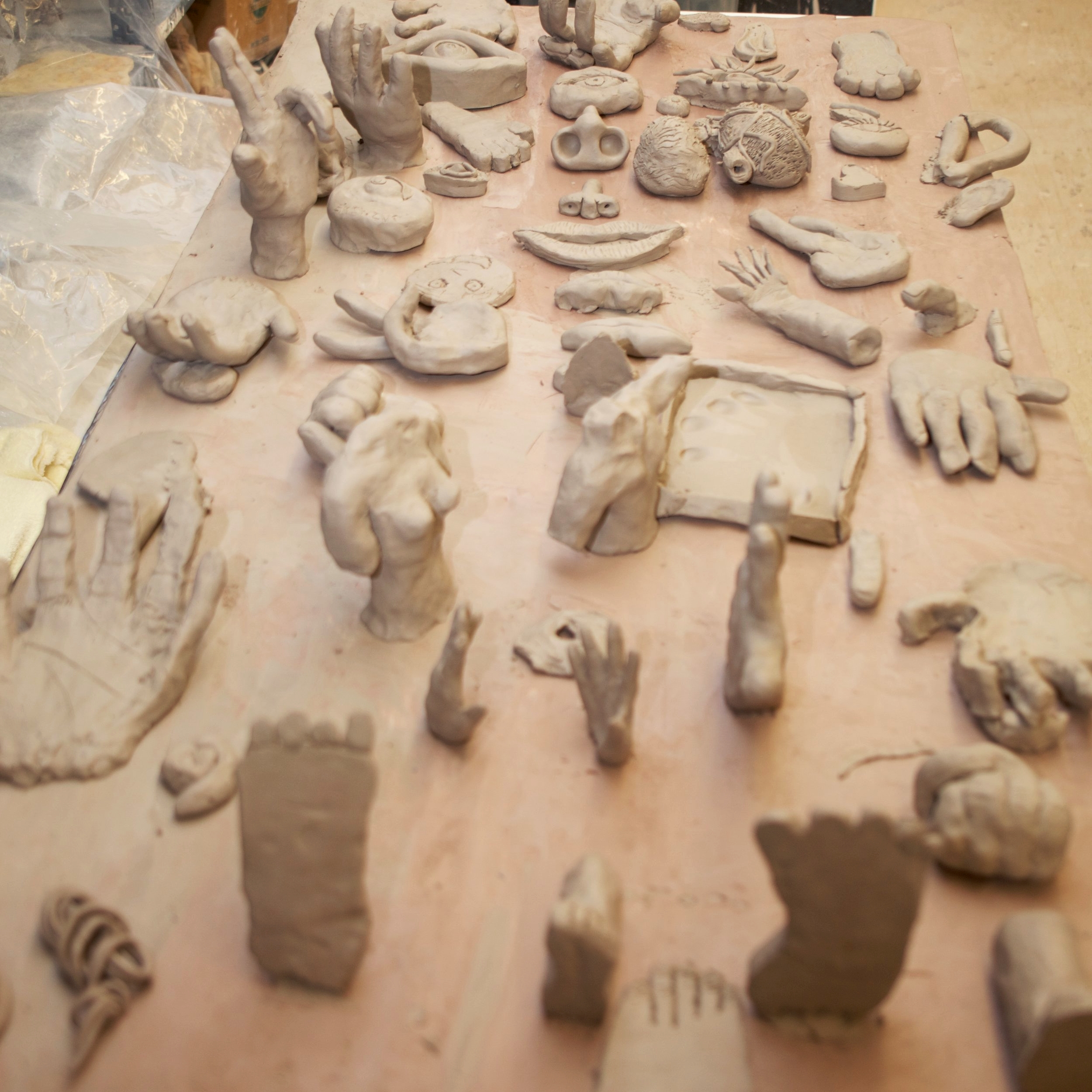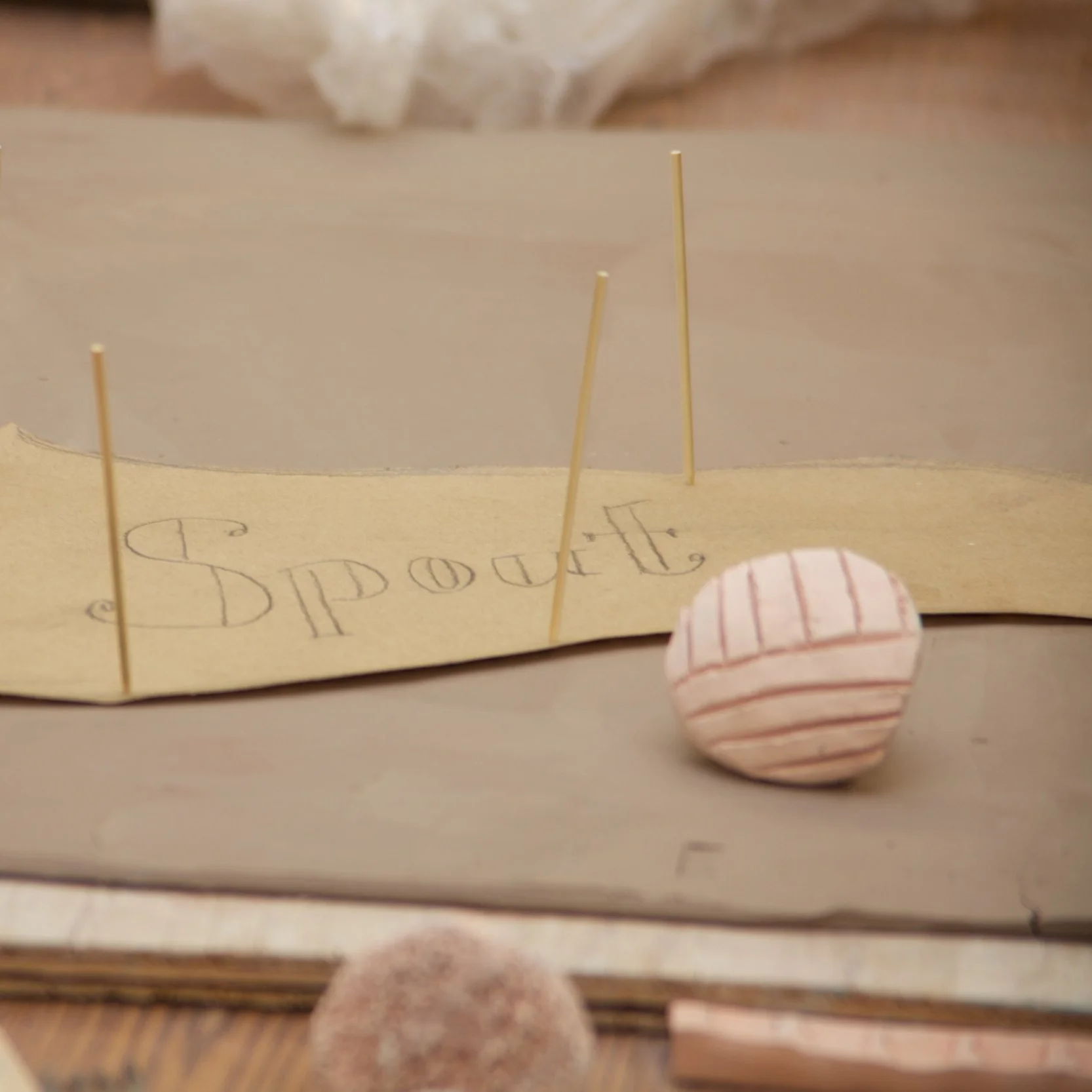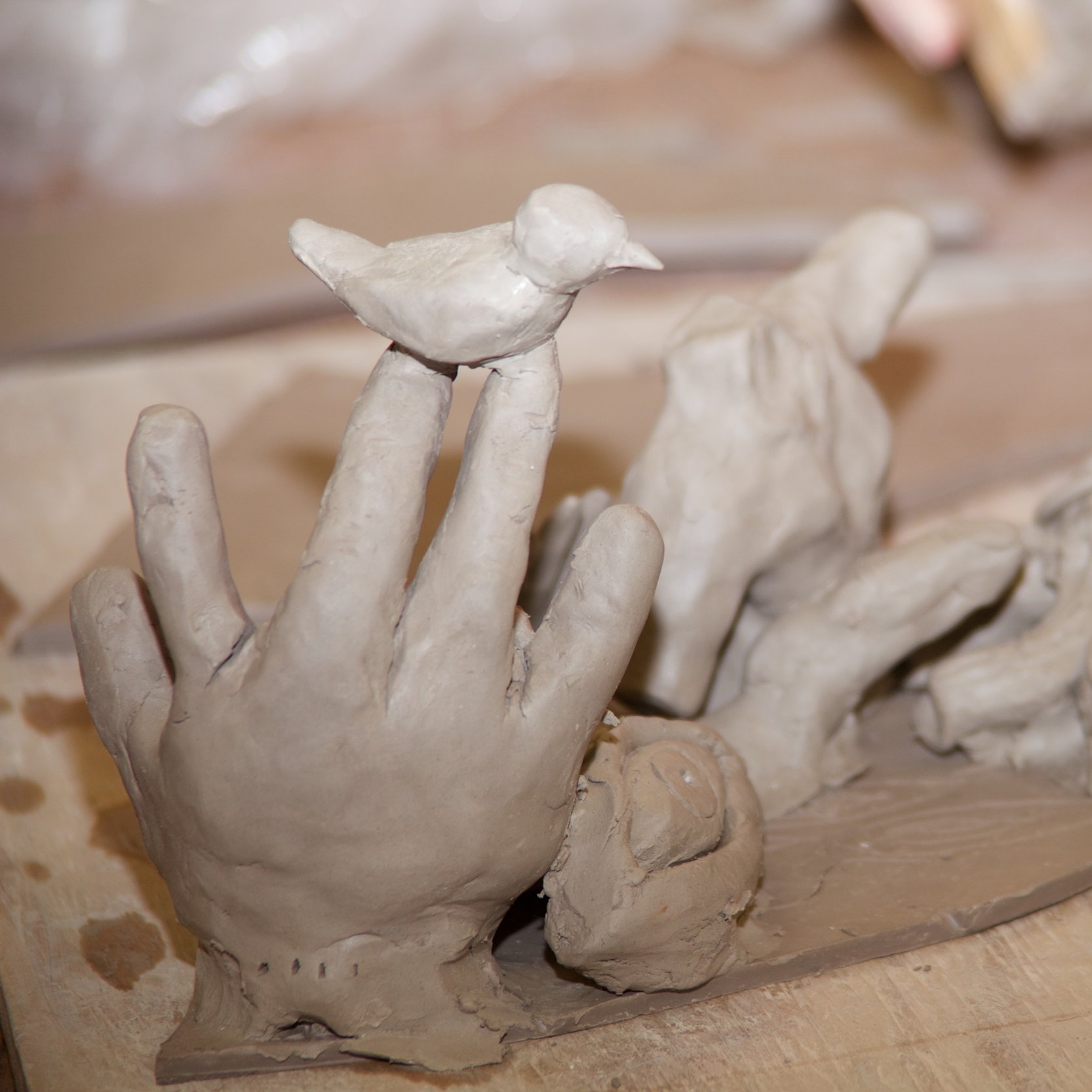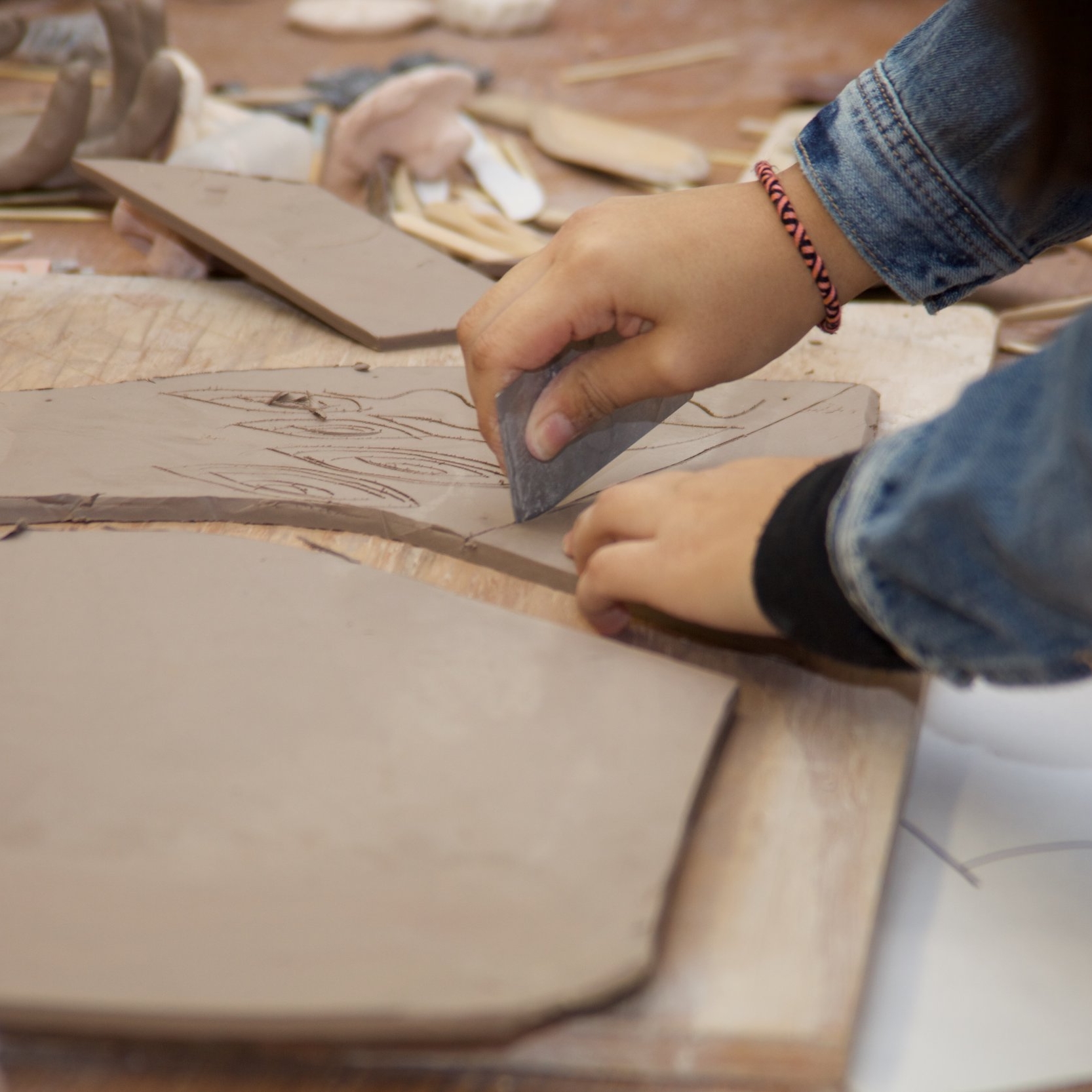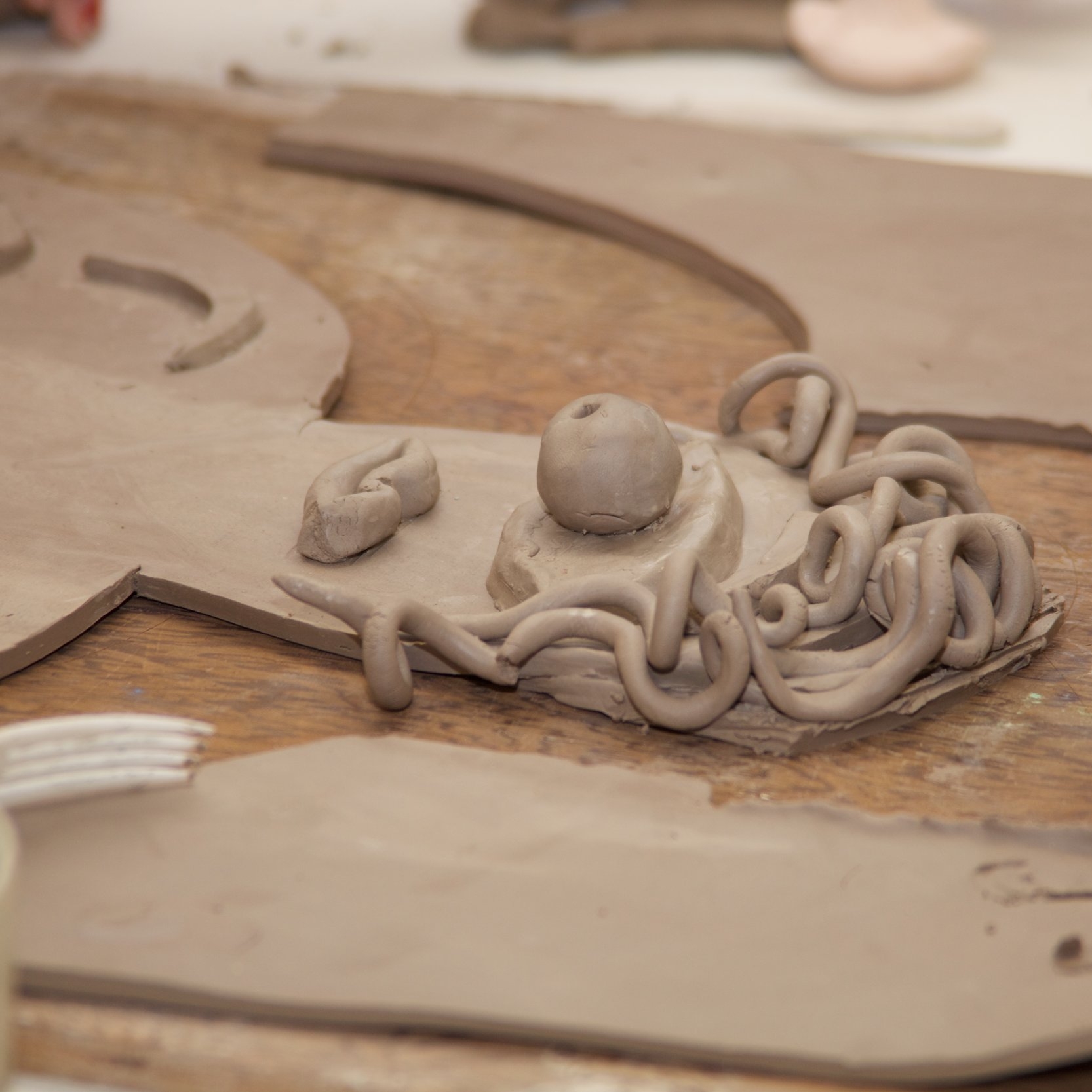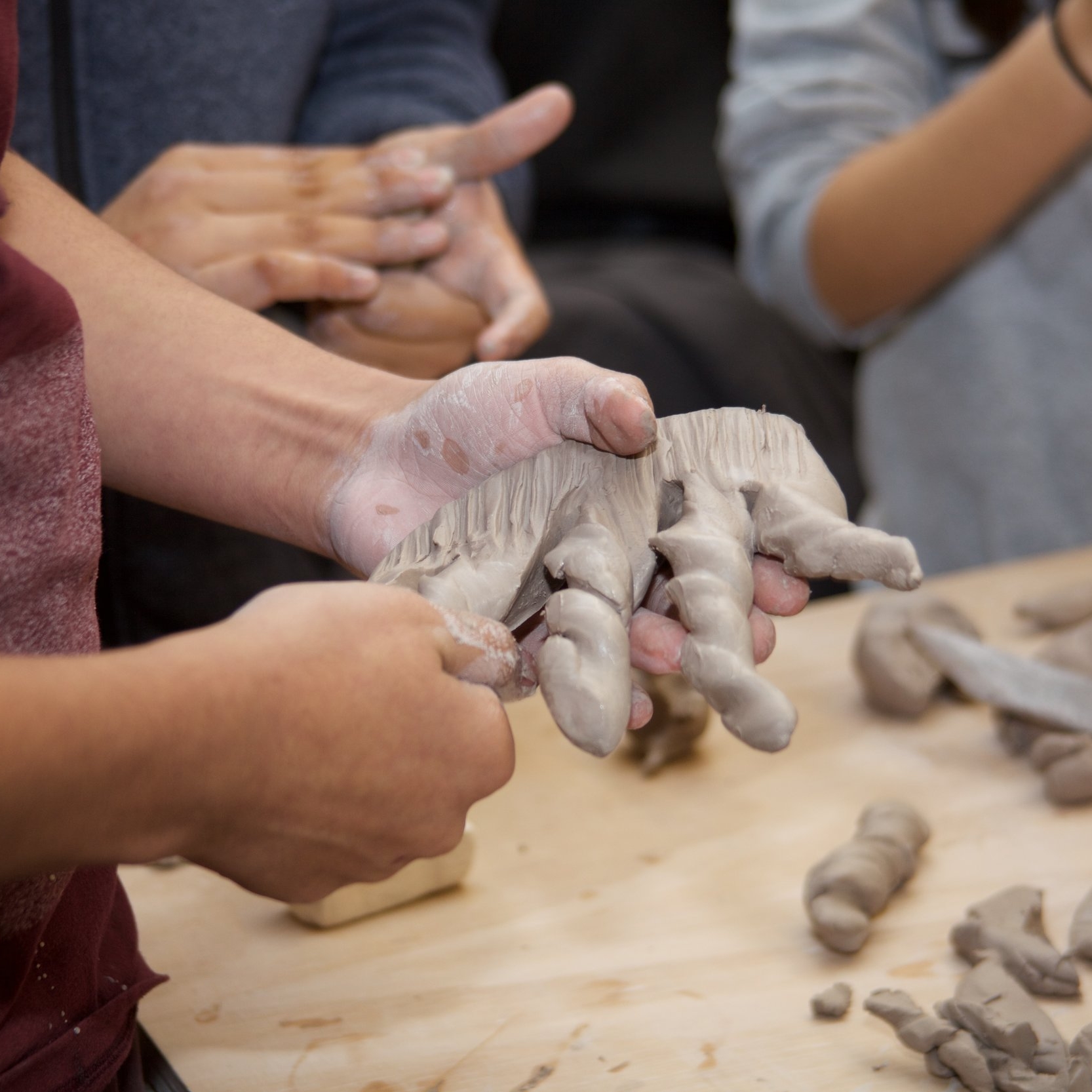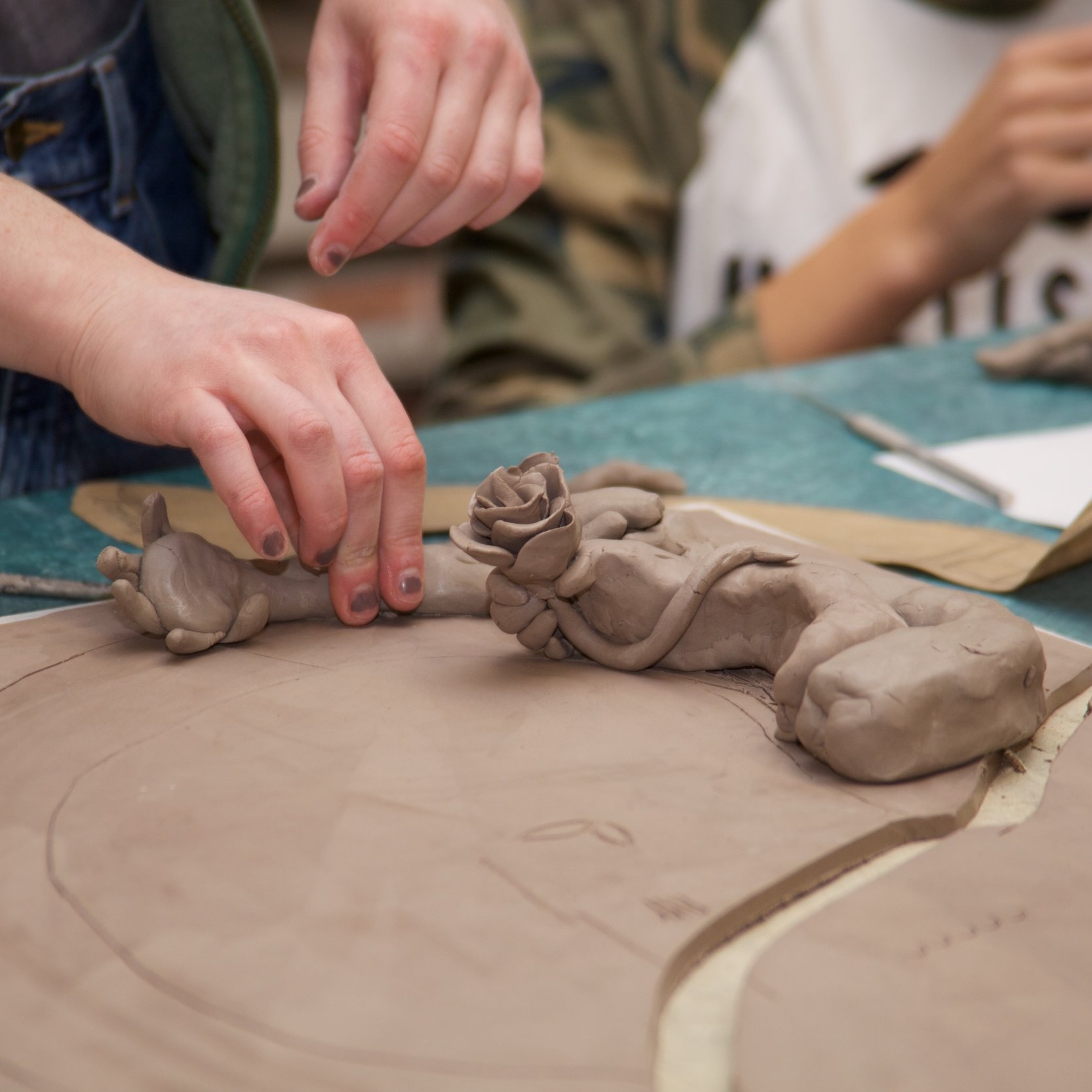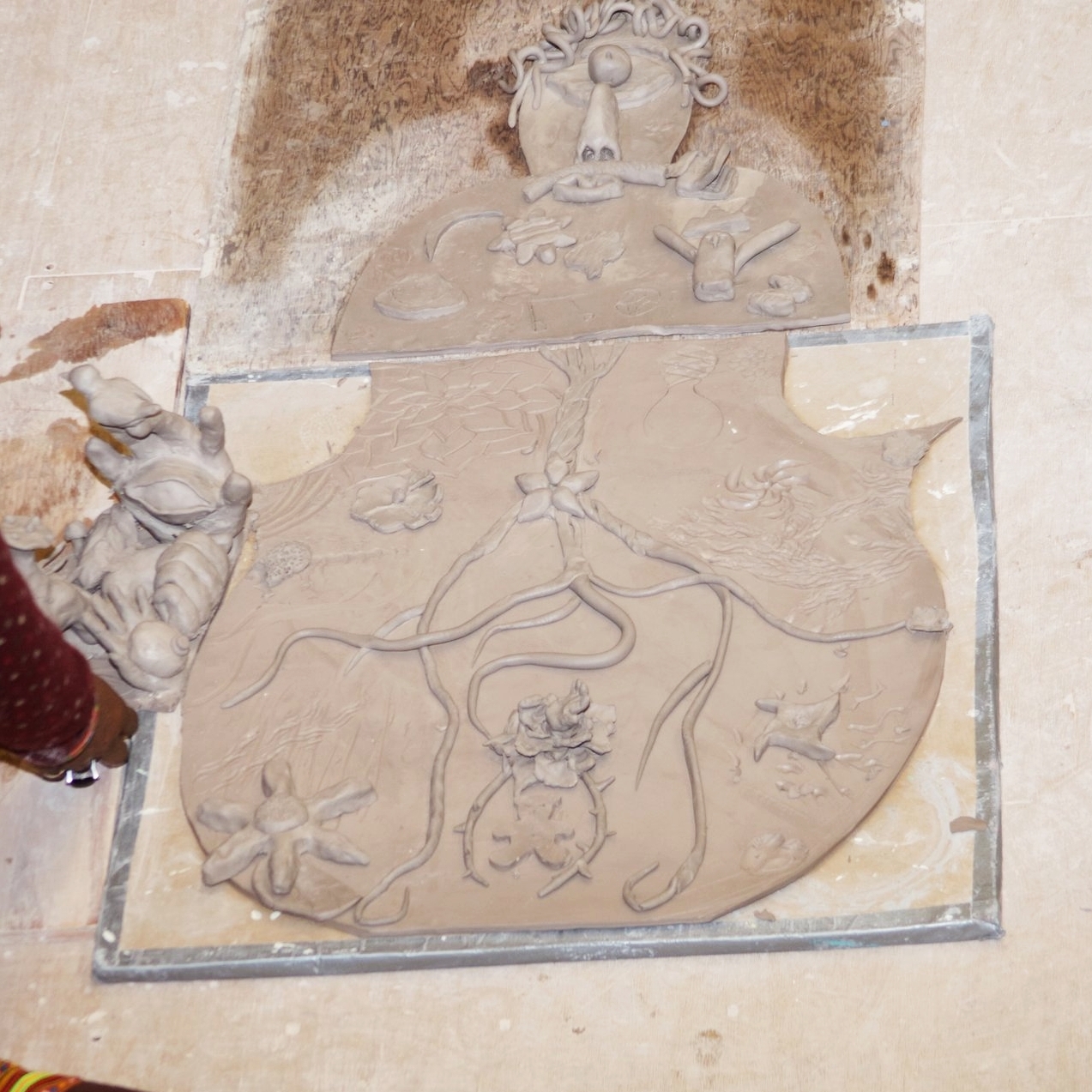Who Am I? Youth Symposium
On March 6th 2018, approximately 50 students from Port Chester High School, White Plains High School and Ossining High School joined us at Clay Art Center for our first Youth Symposium, titled Who Am I? Exploring Identity Through the Arts. Students participated in a complete experiential exercise in identity formation through art making. This incorporated a discussion of personal expression in Clay Art Center’s nationally recognized gallery, where students considered the vessel-based artworks in our current exhibition Me, Myself and I. Presentations by artists and activists Kris Grey, Sana Musasama, and Zeltzin Sanchez led to discussions of differing life perspectives and the challenges young people face today.
The students started the day in our gallery. Clay Art Center’s 2018 gallery year, titled 4 Degrees of Separation, is featuring four core exhibitions considering the social connections made in our daily encounters, such as connections made on the job, within a community, among our friends, and even our relationship with diverse groups. The exhibits focus on the intricacies of individualism, racial biases, national identity, and environmental concerns. Curated by Kathy King, our first exhibition of the year; Me, Myself and I presents artists such as Cheyenne Rudolph, Beth Lo and Matt Nolen who all use clay to highlight concepts around the self. Using the vessel as a platform, 50 juried artists consider how they view themselves, how society, family and relationships effect their self-concept and the role played by culture, lineage and characteristics of personality in the formation of their self-definition.
Separated into three groups, students were led by presenter Kris Grey to engage with sculptural vessels using Visual Thinking Strategies, a method that aims to allow students to form their own opinions and have an unfiltered interaction with the artwork. Using a singular prompting question, What is going on in this piece? Grey led the students to discuss mature artworks and allowed expression of their own opinions and relationships to the works, while continuously reflecting and acknowledging an understanding of what each student described. With a special focus on a large wall piece titled Kiln God by NY based artist Matt Nolen, the students uncovered themes of outside influences on one’s personality, disjointedness in identity, and the difference between internal feeling states and outwardly expressed emotions.
In addition to gallery discussions, students toured the Clay Art Center studio and had the opportunity to speak to Artists-in-Residence and professional artists working in our facility. Students then delved into hands-on clay work with Sana Musasama and Zeltzin Sanchez to explore important aspects of their own identity. Students discussed ideas of physical appearance, gender, orientation, heritage and race, life goals, personal perspectives and even spirituality. From these discussions, students created a menagerie of body parts. Hands in gestures of peace, openness, and resistance were created along with facial features such as eyes, ears, and noses. Each piece was situated on a clay “stage” and students discussed the significance of placement and the interaction of objects with each other.
Following these interactive activities students gathered to listen as our three panelists shared their own journey of self-exploration and identity formation, with a focus on topics such as gender, orientation, race, feminism, immigration and community. While all three speakers, being a Transgender individual, an African American woman, and a young “Dreamer” have all had significantly different life experiences, they shared a common thread of other-ism and oppression. The students in attendance all come from different towns and cities, as well as racial and cultural backgrounds; however, as teenagers they are all in a life space in which they are questioning Who am I? and Am I free to be this person in the world around me? A question, which our talented presenters were able to shed light on.
Kris Grey, formally Kristen Grey discussed his experience as a transgender individual. Grey’s artwork has largely focused on challenging societal norms of gender and sexual orientation in an effort to bring more awareness to the struggles of transgender and LGBT individuals. In an atmosphere of acceptance and a willingness to answers difficult questions, Grey poignantly bridges a gap between what is acceptable and what is considered taboo by society. Grey’s work documents aspects of his transition from female to male and includes ceramic sculpture, performance art, videography and photography.
Sana Musasama highlighted a history of racial inequity in the United States of America and discussed her interpersonal struggle of becoming an artist. The complete lack of a black artist as a role model made the pursuit of a career in the arts questionable for both Musasama and her family. However, after meeting one influential artist with whom she identified, Musasama recognized her potential as an artist. Using the arts, and primarily clay, she began to explore African and American slave cultures as a means of reconnecting with her history. A discussion of her current works includes the recreation of Topsy Turvy Dolls. In times of slavery, African American children were not permitted toys or dolls of their own. Mothers creatively sewed dolls that doubled as white and black. Musasama pointed out that African American professional role models are still difficult to name in many fields, such as the arts, which may not be accessible to communities of color.
A graduate of Port Chester High School, and Clay Art Center’s own Around the World in Clay program, Zetlin Sanchez connected with the audience easily. Sanchez spoke about her experience as a non-American who considers the United States to be her home. Sanchez immigrated to the U.S.A with her mother at the age of six, and is a current recipient of Deferred Action for Childhood Arrivals (DACA). Sanchez discussed the duality of her identity as an assimilated American, and an Indigenous Mexican. While she can speak fluent English without an accent, she comes from a home in which English is not the primary language and has strong roots to her cultural heritage as a Native Mexican. Growing up immersed in spiritual retreats Sanchez shared that she created artworks, and ceremonial clothing for various festivals and prayer circles. As a young adult these experiences have combined with her position as a Community Organizer, in which she has led peaceful protests and worked to engage the Latinx community members to voice their needs in politics. Sanchez encouraged the audience to become politically involved and add their voice to the conversation, pointing towards art as powerful catalyst, while sharing her own experience of using the arts in activism, protest and the practice of her own beliefs.
(For a full biography of all panelist, please scroll to the bottom of the page)
Our symposium concluded with a hands-on activity in which students considered the relation of the vessel to the human body. Drawing from metaphorical representations associated with the parts of a teapot and their particular function, students worked in five separate groups to create a sculptural teapot. Focusing on the foot, body, handle, spout and lid of the teapot, students identified themes in a brief brainstorm session. For example, those focusing on the foot pointed towards metaphors such as support, foundations and family roots, whereas those working on the handle thought more about connectivity, interactions with others, and how they protect themselves from being hurt or “burned”. The five panels were all brought together to form the larger piece and students marveled at how many similar aspects had been incorporated in different areas of the teapot without discussion among groups. We noted continual elements of nature in the form of vines and roots, as well physical characteristics that lacked gender identifiers, much like those created in the icebreaker activity.
Through this hands-on and experiential activity, students uncovered individual and communal reflections of life experiences, noted differences and similarities among each other and ultimately begin to recognize some of the building blocks in their own identity formation. A follow up discussion of the activity included ideas of interconnectedness between all people despite very differing identities and life perspectives - a concept we were happy to help sculpt in the minds of these young adults.
Panelist Biographies
Kris Grey is a New York City based gender-queer artist whose cultural work includes curatorial projects, performance, writing, and studio production. Grey earned a Bachelor of Fine Art from the Maryland Institute College of Art and a Masters Degree in Fine Art from Ohio University. They perform, teach, and exhibit work internationally. Grey was a Fire Island Artist Residency recipient, a resident artist for the ANTI Festival for Contemporary Art in Kupoio, Finland, and a teaching artist at The International Centre for Training in the Performing Arts in Brussels, Belgium. In addition to their individual practice, Grey collaborates with Maya Ciarrocchi under the moniker Gender/Power. Gender/Power has been awarded a Baryshnikov Art Center residency, a Lower Manhattan Cultural Council residency, a Franklin Furnace grant, and a MAP Fund Grant. Recent curatorial projects include Queer Objectivity at the University of Maryland, MIX NYC Experimental Film and Performance Festival, and the Queer Culture Performance and Lecture Series at the Fashion Institute of Technology. Grey's writing has been published in print and on the web for Huffington Post and Original Plumbing. Their latest writing, Trans*feminism: fragmenting and re-reading the history of art through a trans* perspective, written in collaboration with Jennie Klein, was published in Otherwise: Imagining Queer Feminist Art Histories.
Sana Musasama received her BA from City College of New York, NY (1973) and her MFA from Alfred University, NY (1998). Musasama began traveling as way to recover identity and cultural place. Clay was a geographical catalyst that brought her first to West Africa. She studied Mende Pottery in Sierra Leone (1974-75) and ventured later to Japan, China, South America and Cambodia. She has continued her quest, expanding her interest to tribal adornment practices in various indigenous cultures. She is challenged by the concerns surrounding the safety of women, specifically the rituals involving rites of passage, female chastity and the “purification” of the female body. Musasama’s work in informed by history, women’s studies, culture and her travel journal.
Zeltzyn Sanchez “came home” in 2005 when she was brought to the United States of America by her family. At 6 years old she was faced with the challenge of learning how to read, write and speak in both English and Spanish. Sanchez was raised by a single mother of two, who worked both day and night, which greatly influenced her in becoming independent and mature at an early age. Grappling with the understanding that she was not native to this county, she found herself searching to find a place between assimilation and the preservation of her own culture, a struggle that is still relevant for her today. Juggling traditional ceremonies and suburban life led to feelings of misrepresentation of her true self and a distorted self-image. Sanchez has born the label “minority” for as long as she can remember; often recognizing that she has been marketed by others as token of inclusion and diversity. Sanchez has learned to accept this projection as she has grown closer to an understanding that she is simply Zeltzyn - the young, brown, queer, indigenous, undocumented, female activist - just trying to be a person.
